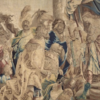Blossoming Flowers Where Mao Wasn’t Looking
The following is a lightly adapted excerpt from Daniel H. Bays, A New History of Christianity in China (Wiley-Blackwell, 2011), and is reprinted by permission of the publisher and the author. We have adopted the headline from Mao’s famous line about letting a hundred flowers blossom.
*****
It appears in retrospect that the Cultural Revolution as a national event, seen at the time as an unmitigated disaster for the church, was actually of great assistance to the growth of Christianity in many places in China.
Mao Zedong’s ‘Great Proletarian Cultural Revolution’ that he launched in 1966 was not aimed primarily at Christians or Christianity. It was aimed at removing from power several top leaders of the communist party, his close colleagues for decades. Since these leaders controlled the Party apparatus, Mao had to seek elsewhere for allies; he found them in the People’s Liberation Army (PLA) and the youth of the nation, mainly of college and high school age.
In their zeal to do Chairman Mao’s bidding, these young people ran amok in cities all across the land, hounding people who were vulnerable (for example, those who ever had ever had any contact at all with foreigners), ransacking their homes, often beating them, sometimes to death. Or they made public spectacles of their victims, torturing and humiliating them, causing yet more thousands of suicides. This early phase of the Cultural Revolution was the one that most affected Chinese Christians. In countless places, Christians were put through such abuse that many did not survive the ordeal.
As Mao and his fellow perpetrators of the Cultural Revolution envisioned it, all truth would spring from “the people” (spoken for by Mao), through “class struggle” (that is, violence). Any ideology other than Mao’s interpretation of Marxism-Leninism was heresy. At this point, still early in the Cultural Revolution (fall 1966 to late 1967), all religions were abolished, and all houses of worship were closed. This was the only time in the past sixty years that a nationwide eradication policy for Christianity was attempted (though some local governments did so in the late 1950s). The only concession the regime granted would come in the early 1970s, when more foreigners were living in China and the Christians among them needed a place to worship.
From 1967 on, the entire next ten or eleven years of Christian history in China are still a black hole, the details of which are very scarce. There are almost no documentary sources to consult, no statistics, very few photographs (and those of uncertain provenance). We are left with the anecdotal stories of things that happen to people individually or that they personally witnessed during these years. With the life and death struggle for power going on at the top, few were paying attention to the results of the Cultural Revolution at the bottom of society. The party, government, and other authority structures at the local level all over the country were paralyzed or dismantled by the chaos of the Cultural Revolution. Anarchy ensued in some areas, with groups of Red Guards, radical workers, and others engaged in deadly armed warfare. In other areas, coalitions of army, party, and government representatives maintained a fragile stability. The PLA maintained an uneasy sway over the country as a whole, pending the resurrection of the party and the government.
The overall result seems similar to what happened in the Dominican mission of northeast Fujian Province in the Ming-Qing transition of the mid-17th century. The turmoil of the Cultural Revolution in similar fashion gave Christianity an opening, an opportunity to grow. All churches during these years were by definition house churches, and some proved very adept at adjusting to the new situation. Talented and charismatic leaders emerged among the believers and proved to be effective evangelists, recruiting many new converts. Despite the almost total lack of empirical evidence, my guess is that Protestants increased their numbers by a factor of five or six during the 12 years from 1966 to 1978, when churches reopened.
Obviously this level of analysis is very crude. Conditions varied around the country, and different factors were undoubtedly at play. The message preached by the evangelists was largely (as far as we can tell) the old, pre-1949 salvationist and revivalist message typical of most theologically conservative missionaries such as those of the China Inland Mission and the Chinese leaders like John Sung, Watchman Nee, and Wang Mingdao. It was millenarian, looking to the imminent return of Christ, and it was to an extensive degree Pentecostal, that is, highlighting “gifts of the spirit” such as speaking in tongues, prophesies, and miraculous healings. Some of the old sectarian enthusiasm of the True Jesus Church and Watchman Nee’s teachings have provided renewed impetus to grow. In fact, many home churches at this time were in effect shaped by True Jesus input or by followers of Nee (who died in a prison camp in 1972). I am not sure we can go much further than these observations about the kind of Protestant development that took place during the Cultural Revolution, or if the later crossover between Protestant and Chinese folk religion or popular religion was already occurring. Finally: my estimate is five to six million Protestants, and a very rapid growth rate in the late 1970s.
Thus Protestants emerged from the Cultural Revolution after 1976 in a dynamic mode, spreading culturally and naturally.








